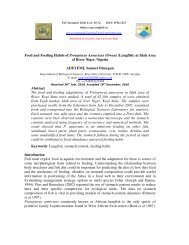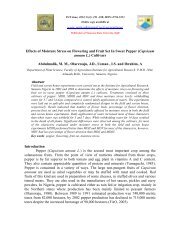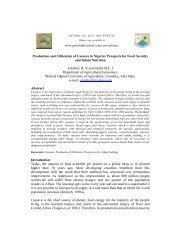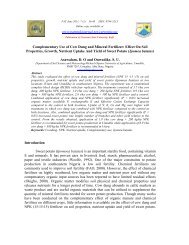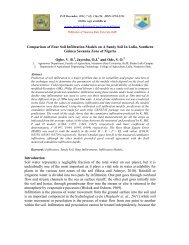The Replacement Value of Pigeon Pea (Cajanus Cajan) For Maize ...
The Replacement Value of Pigeon Pea (Cajanus Cajan) For Maize ...
The Replacement Value of Pigeon Pea (Cajanus Cajan) For Maize ...
You also want an ePaper? Increase the reach of your titles
YUMPU automatically turns print PDFs into web optimized ePapers that Google loves.
PAT 2009; 5(1): 67-74<br />
ISSN: 0794-5213; Iorgyer et al; <strong>The</strong> <strong>Replacement</strong> <strong>Value</strong> <strong>of</strong> <strong>Pigeon</strong> <strong>Pea</strong> …….68<br />
<strong>Pigeon</strong> pea (<strong><strong>Cajan</strong>us</strong> cajan) is one <strong>of</strong> the most common legumes <strong>of</strong> the tropics and subtropics<br />
with a wide adaptability (Wallies and Byth, 1988). Rachie (1975) reported that<br />
pigeon pea is a legume that shows great potential in Nigeria and to which efforts <strong>of</strong> the<br />
International Institute <strong>of</strong> Tropical Agriculture (IITA) were directed for improvement.<br />
<strong>Pigeon</strong> pea is truly a multipurpose nitrogen fixing plant that provides food, fuel wood,<br />
fodder and shelter material to subsistence farmers. <strong>The</strong> seeds can be used as animal feed<br />
and harvest trash consisting <strong>of</strong> shells, leaf and young stems has good fodder value.<br />
<strong>Pigeon</strong> pea is drought tolerant and has greater adaptability to poor soil conditions than<br />
most tropical legumes (Akinola and Oyejola, 1994). It is widely cultivated throughout<br />
the tropics as a cover crop or green manure crop and it has high dry matter yield<br />
potential. Aduku (1993) gave the nutritional composition <strong>of</strong> pigeon pea seed as: 23.77%<br />
CP, 1.1% fat, 7.49% CF, 0.13% Ca, 0.28% P, 1.66% lysine, 0.36% methionine, 0.29%<br />
cystein, 1.59% arginine and 0.11% tryptophan. <strong>Pigeon</strong> peas low food value for humans<br />
due to low palatability when compared to cowpea and prolonged cooking time, coupled<br />
with no industrial use in Nigeria as <strong>of</strong> now (Amaefule and Obioha, 2001), qualifies it as<br />
a suitable replacement for maize. Iorgyer et al (2008) replaced 0, 25, 50, 75 and 100%<br />
<strong>of</strong> weaner rabbit diets with pigeon pea and recorded no significant (P>0.05) difference<br />
among treatments on rabbit performance. <strong>The</strong>y however reported feed cost /kg gain on<br />
pigeon pea based diets to be significantly (P



